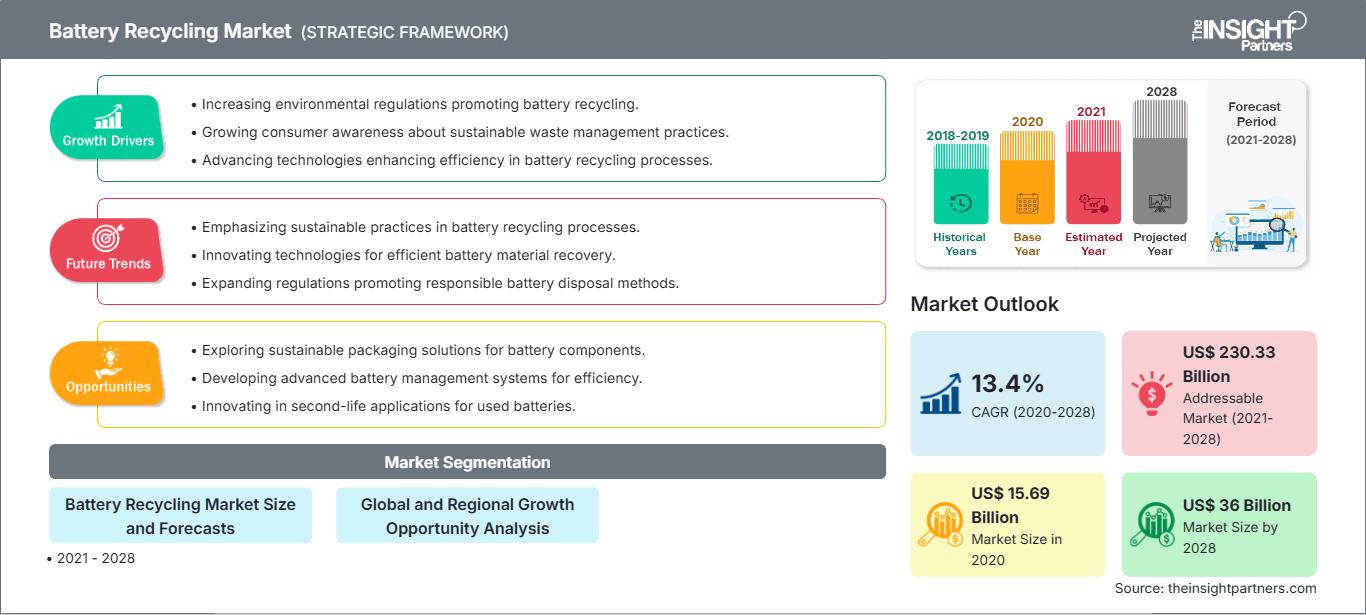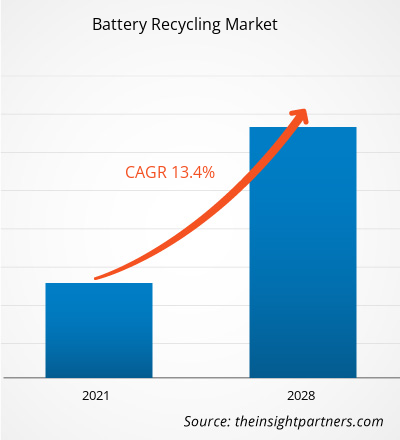[Research Report] The battery recycling market was valued at US$ 15,690.07 million in 2020 and is projected to reach US$ 36,002.73 million by 2028; it is expected to grow at a CAGR of 13.4% from 2021 to 2028.
MARKET ANALYSIS
Battery recycling is an effective way to reprocess and reuse the waste batteries. Recycling has been identified to be one of the significant concepts, creating lower environmental impacts in comparison to the mining of virgin materials. Direct recycling could substantially lower down the energy consumption as well as reduce emissions. The recycling of used electric batteries encompasses huge potential and yields strong economic benefits. Several policies and regulations have been framed which play a vital role in consumer product safety, safe handling, storage and treatment, reuse, recycling, and disposal of batteries used across various application bases.
GROWTH DRIVERS AND CHALLENGES
The increasing government regulations for battery disposal and recycling has aided the battery recycling market growth. Policymakers have framed several regulations regarding the effective utilization and disposal of waste battery materials, which are significantly contributing to the expansion of the battery recycling market. Such policies play a vital role in consumer product safety, safe handling, storage and treatment, reuse, recycling, and disposal of batteries used across various application bases. For instance, as per the Environmental Protection Agency (EPA), lithium-ion batteries deployed in products such as electronics and electrical appliances, consumer goods, electric vehicles, and electrical energy storage systems, should be handled and disposed of carefully. Single-use, non-rechargeable lithium metal batteries, and re-chargeable lithium-polymer cells (Li-ion, Li-ion cells) are categorized as two types of lithium batteries that are used by consumers base and require effective waste management to avoid environmental degradation. Various regulations and bodies involved in the recycling of lithium-ion batteries include European Union Batteries Directive, GRS Batterien Foundation (Germany), The Japan Battery Recycling Centre (JBRC), and NEV battery recycling regulations (China). Similarly, as per an article published by European Parliamentary Research Service (EPRS) in July 2021, more than 1.9 million tons of waste batteries are generated every year in Europe. The collection and recycling rates, coupled with the profitability of recycling and the impact upon the environment and health, are heavily reliant upon the battery technology or type. However, several challenges are associated with the battery recycling market, especially with lithium-ion batteries. The costs of recycling is too high in comparison with those occurring from extracting and refining virgin resources, owing to the number of steps and processes involved to collect, recycle, and deliver finished products to customers. Thus, this factor is restraining the battery recycling market growth.
Customize This Report To Suit Your Requirement
You will get customization on any report - free of charge - including parts of this report, or country-level analysis, Excel Data pack, as well as avail great offers and discounts for start-ups & universities
Battery Recycling Market: Strategic Insights

-
Get Top Key Market Trends of this report.This FREE sample will include data analysis, ranging from market trends to estimates and forecasts.
REPORT SEGMENTATION AND SCOPE
The "Global Battery Recycling Market Analysis to 2028" is a specialized and in-depth study with a major focus on the global battery recycling market trends and growth opportunities. The report aims to provide an overview of the global battery recycling market with detailed market segmentation by type, battery source, and geography. The global battery recycling market has been witnessing high growth over the recent past and is expected to continue this trend during the forecast period. The report provides key statistics on the consumption of battery recycling worldwide along with their demand in major regions and countries. In addition, the report provides the qualitative assessment of various factors affecting the battery recycling market performance in major regions and countries. The report also includes a comprehensive analysis of the leading players in the battery recycling market and their key strategic developments. Several analyses on the market dynamics are also included to help identify the key driving factors, market trends, and lucrative battery recycling market opportunities that would, in turn, aid in identifying the major revenue pockets.
Further, ecosystem analysis and Porter’s five forces analysis provide a 360-degree view of the global battery recycling market, which helps understand the entire supply chain and various factors affecting the market growth.
SEGMENTAL ANALYSIS
The global battery recycling market is segmented based on type, and battery source. Based on type, the battery recycling market is segmented as lead acid battery, lithium-based battery, nickel-based battery, and others. Based on battery source, the market is classified as automotive, industrial, household, consumer electronics, and forklift.
Based on type, the lead acid battery segment accounted for a significant battery recycling market share. The lead acid battery is a type of rechargeable battery that has the lowest energy density. The battery can supply high surge currents which indicate that the cells have a large power-to-weight ratio. The cost of the lead acid batteries is comparatively low which makes them an ideal choice for use in motor vehicles to provide the high current required by starter motors. On the basis of battery source consumer electronics led the battery recycling market with a largest market share. Various office, household, and entertainment devices along with lighting and tools for the home are being powered by consumer batteries. Consumer batteries are mostly used for powering small portable electronic devices such as laptops, cell phones, remote control, power tools, video game systems and other such devices that requires energy without a cord.
REGIONAL ANALYSIS
The report provides a detailed overview of the global battery recycling market with respect to five major regions, namely, North America, Europe, Asia-Pacific (APAC), Middle East and Africa (MEA) and South & Central America. Asia Pacific accounted for a significant share of the market and valued at more than US$ 8400.00 million in 2022. Asia Pacific comprises several developing and developed economies such as China, India, Japan, South Korea, and Australia. The region has seen a rise in the consumption of lithium-ion batteries, owing to the growth of the automotive sector and increased penetration of electric vehicles in the region. North America is also expected to witness considerable growth valued at approximately US$ 6600.00 million in 2028, wing to various government regulations, along with an increase in demand for electric vehicles in the region. Furthermore, in Europe, there has been a rising development of battery recycling capabilities to recycle the increasing volume of waste batteries in the region. This has created lucrative opportunities in battery recycling market. The battery recycling market in Europe is augmented to grow at CAGR of 13.7% during the forecast period.
INDUSTRY DEVELOPMENTS AND FUTURE OPPORTUNITIES
Partnership, acquisitions, and new product launches were found to be the major strategies adopted by the players operating in the global battery recycling market.
In May 2023, Aqua Metals, Inc. and 6K Energy announce partnership to develop next generation of sustainable materials for lithium batteries.
In 2021, Retriev Technologies has announced the completion of its first volume shipment of recovered battery materials to Tokyo-based manufacturer Marubeni Corp. Marubeni Corp. and Retriev Technologies Inc. announced a strategic partnership for developing an innovative business model for end-of-life lithium-ion batteries (EOL LIB).
IMPACT OF COVID/IMPACT OF GEOPOLITICAL SCENARIO/IMPACT OF RECESSION
Lockdowns, travel restrictions, and business shutdowns due to the COVID-19 pandemic adversely affected economies and industries in various countries in North America, Europe, Asia Pacific (APAC), South & Central America, and the Middle East & Africa (MEA). The crisis disturbed global supply chains, manufacturing activities, delivery schedules, and essential and nonessential product sales. Various companies announced possible delays in product deliveries and a slump in future sales of their products in 2020. Further, the international travel bans imposed by various governments in Europe, Asia Pacific, and North America forced several companies to discontinue their collaboration and partnership plans. All these factors hampered the chemicals & materials industry in 2020 and early 2021, thereby restraining the growth of various markets related to this industry, including the battery recycling market.
Before the COVID-19 outbreak, the battery recycling market was mainly driven by the rising demand from automotive, power, and electronics industries. However, in 2020, various industries had to slow down their operations due to disruptions in value chains caused by the shutdown of national and international boundaries. The COVID-19 pandemic disrupted the supply chain of key raw materials and disturbed manufacturing processes due to restrictions imposed by government authorities in various countries. As per an article published by National Center for Biotechnology Information in December 2020, the pandemic has significantly impacted the recycling chain which involves shipping of expended batteries for reprocessing stretches across the world. Such factors reduced the recycling rate of battery.
Battery Recycling Market Regional InsightsThe regional trends and factors influencing the Battery Recycling Market throughout the forecast period have been thoroughly explained by the analysts at The Insight Partners. This section also discusses Battery Recycling Market segments and geography across North America, Europe, Asia Pacific, Middle East and Africa, and South and Central America.
Battery Recycling Market Report Scope
| Report Attribute | Details |
|---|---|
| Market size in 2020 | US$ 15.69 Billion |
| Market Size by 2028 | US$ 36 Billion |
| Global CAGR (2020 - 2028) | 13.4% |
| Historical Data | 2018-2019 |
| Forecast period | 2021-2028 |
| Segments Covered |
By Battery Recycling Market Size and Forecasts
|
| Regions and Countries Covered |
North America
|
| Market leaders and key company profiles |
|
Battery Recycling Market Players Density: Understanding Its Impact on Business Dynamics
The Battery Recycling Market is growing rapidly, driven by increasing end-user demand due to factors such as evolving consumer preferences, technological advancements, and greater awareness of the product's benefits. As demand rises, businesses are expanding their offerings, innovating to meet consumer needs, and capitalizing on emerging trends, which further fuels market growth.

- Get the Battery Recycling Market top key players overview
COMPETITIVE LANDSCAPE AND KEY COMPANIES
Some of the key players operating in the battery recycling market include Aqua Metals, Inc.; Call2recycle, Inc.; Clarios. Llc; Com2 Recycling Solutions; East Penn Manufacturing Company; Exide Technologies; G P Batteries; Gopher Resource Llc; Retriev Technologies Inc; and Terrapure Environmental Ltd among others.
Frequently Asked Questions
Based on application, why consumer electronics segment accounted for the largest share in the global battery recycling market?
- Historical Analysis (2 Years), Base Year, Forecast (7 Years) with CAGR
- PEST and SWOT Analysis
- Market Size Value / Volume - Global, Regional, Country
- Industry and Competitive Landscape
- Excel Dataset
Recent Reports
Related Reports
Testimonials
Reason to Buy
- Informed Decision-Making
- Understanding Market Dynamics
- Competitive Analysis
- Identifying Emerging Markets
- Customer Insights
- Market Forecasts
- Risk Mitigation
- Boosting Operational Efficiency
- Strategic Planning
- Investment Justification
- Tracking Industry Innovations
- Aligning with Regulatory Trends





















 Get Free Sample For
Get Free Sample For